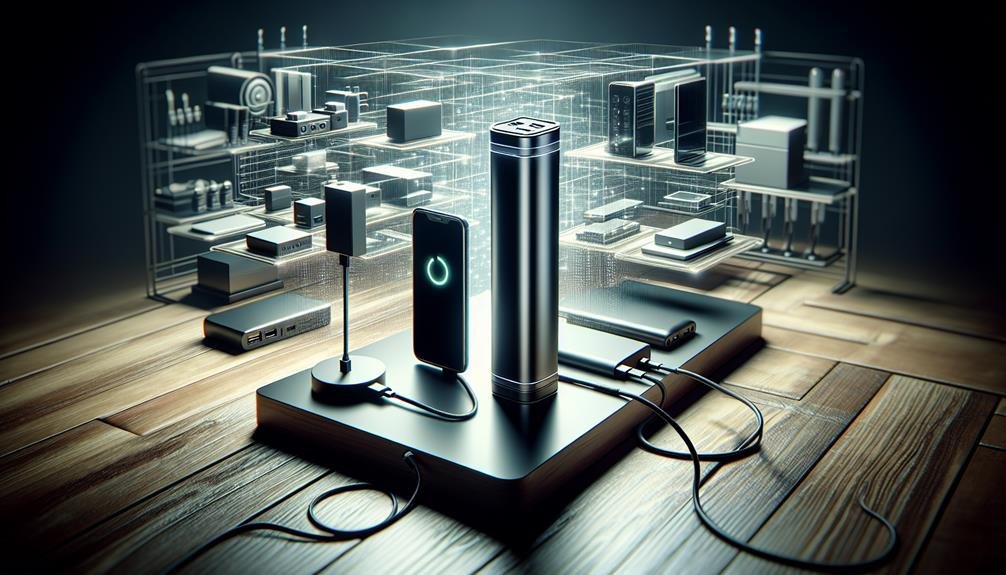Yes, you can charge a power bank with a mobile charger, provided the voltage and amperage specifications match. Make sure your mobile charger supports the power bank's input requirements, typically listed on the power bank. Using cables of good quality and avoiding damaged ones is essential. Overcharging or using improper chargers can harm battery health and efficiency. USB-C chargers usually offer faster charging, which might be advantageous. For best safety and performance, utilize recommended adapters and maintain proper heat management practices. If used correctly, you'll find this guarantees efficient and safe charging procedures for your power bank and devices.
Understanding Power Banks
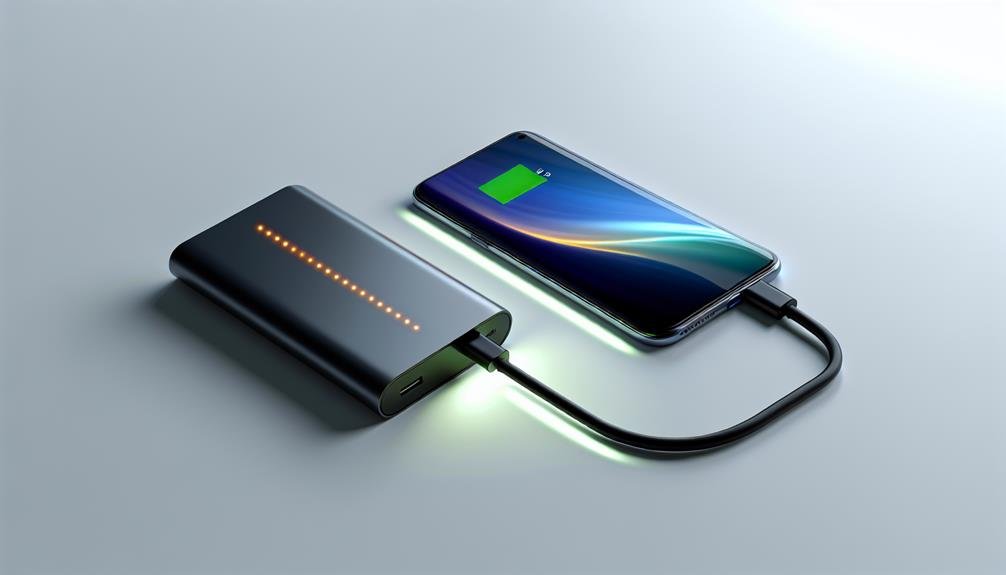
Understanding power banks, you'll need to grasp their essential components and operational principles to effectively utilize them for charging your mobile devices. A power bank, basically a portable battery, stores electrical energy that can later be used to recharge your devices. One critical aspect you'll need to take into account is the power bank capacity, typically measured in milliampere-hours (mAh). This figure indicates how much charge the power bank can hold; a higher mAh rating means more capacity, allowing for multiple charges of your mobile device.
To ensure safe and efficient usage, pay close attention to the charging indicators on your power bank. These indicators, often LED lights, provide real-time information about the charging status and remaining battery capacity. For instance, a fully charged power bank may display four illuminated LEDs, while fewer lights indicate a lower charge level. Understanding these indicators helps you avoid overcharging or undercharging, both of which can compromise the longevity and safety of your device.
Mobile Charger Basics
Mobile chargers, essential for keeping your devices powered, convert alternating current (AC) from wall outlets into direct current (DC) suitable for battery charging. Understanding the technical nuances of mobile chargers can greatly enhance safety and efficiency. These chargers typically output between 5V to 20V, depending on the device and charger specifications.
When choosing a charger, it's important to take into account the connection types. USB-A and USB-C are the most common, with USB-C offering faster charging capabilities due to its higher power delivery capacity. To ensure ideal charging, always use the cable type that matches your charger's output specifications and your device's input requirements.
For safety, follow these charging tips: avoid using damaged cables as they can cause short circuits, and always plug your charger directly into a wall outlet rather than an extension cord. Be mindful of the charger's wattage; using a charger with higher wattage than your device supports can lead to overheating and potential damage.
Compatibility Check
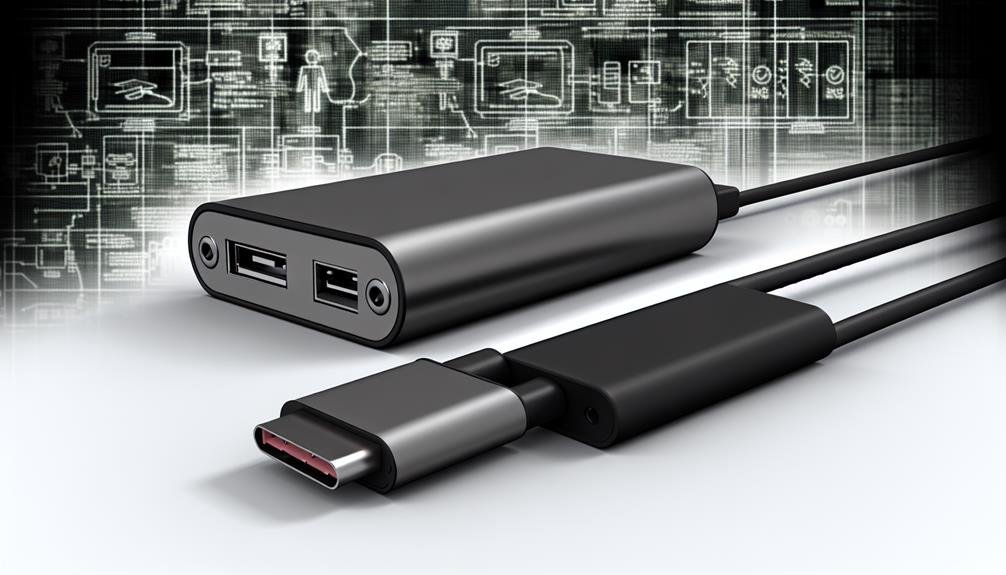
To confirm that your mobile charger is suitable for your power bank, you must verify the charger's voltage requirements and connector type compatibility. An incorrect voltage can damage the power bank or reduce its efficiency, while an incompatible connector type will prevent charging altogether. Always match the charger's output specifications with the power bank's input specifications to avoid any operational issues.
Charger Voltage Requirements
Verifying charger voltage compatibility is crucial for both the efficiency and longevity of your power bank, as mismatched voltage levels can lead to subpar performance or even damage the device. When selecting a mobile charger for your power bank, you must confirm that the voltage compatibility aligns with the power bank's specifications. Typically, power banks operate at a standard voltage of 5V, but some high-capacity models may require higher voltages.
In addition to voltage compatibility, you should also consider the amperage requirements. The amperage, or current, determines how quickly your power bank will charge. If your mobile charger's power output doesn't meet the necessary amperage requirements of your power bank, charging may be inefficient or extremely slow. Conversely, using a charger with an excessively high amperage could potentially overheat the power bank, posing safety risks.
To maximize charging capacity, always match the charger's power output to the power bank's input specifications. Check the user manual or manufacturer's guidelines for both devices. Adhering to these parameters minimizes wear and maximizes the lifespan of your power bank, ultimately ensuring a safer and more efficient charging process.
Connector Type Compatibility
When evaluating connector type compatibility, it's important to make sure that both the power bank and the mobile charger utilize the same connector standard, such as USB-A, USB-C, or Micro-USB, to facilitate a seamless and efficient charging process. The charging port on your power bank must match the cable type provided by your mobile charger. For instance, if your power bank has a USB-C charging port, verify that your mobile charger provides a USB-C cable type. This compatibility ensures optimal power transfer, reducing the risk of poor charging efficiency or potential damage.
Moreover, mismatched connectors can lead to loose connections, resulting in intermittent charging and excessive heat generation, which can be hazardous. Analyzing the specifications of both devices can help avoid these issues. The market today has a variety of adapters and cables that can convert one connector type to another, but it's crucial to use high-quality products to maintain a safe charging environment. Always check for certifications like USB-IF or MFi to ensure the adapter or cable meets industry standards. Proper connector type compatibility not only ensures efficient charging but also enhances the longevity and safety of your devices.
Charging Speeds
Charging speeds for power banks can vary greatly depending on the output capacity of the mobile charger and the power bank's input specifications. The charging efficiency is a vital factor influenced by both the voltage and amperage of the mobile charger. For example, a charger with a higher amperage can potentially charge your power bank faster, provided the power bank supports that input. However, exceeding the recommended specifications can lead to diminished charging efficiency and even damage the power bank.
Safety considerations are paramount when discussing charging speeds. Using a charger that doesn't align with your power bank's input specifications can lead to overheating and potential risks such as short-circuiting or battery swelling. Heat management is another crucial aspect. Chargers with higher output can generate more heat, which, if not adequately managed, can degrade the power bank's internal components over time.
To optimize charging speeds while maintaining safety, always use chargers that are specifically recommended by the power bank manufacturer. This ensures compatibility and minimizes risks associated with improper charging. It is vital to read the technical specifications and user manual to understand the best charging conditions for your power bank, ensuring both efficiency and safety.
Safety Considerations
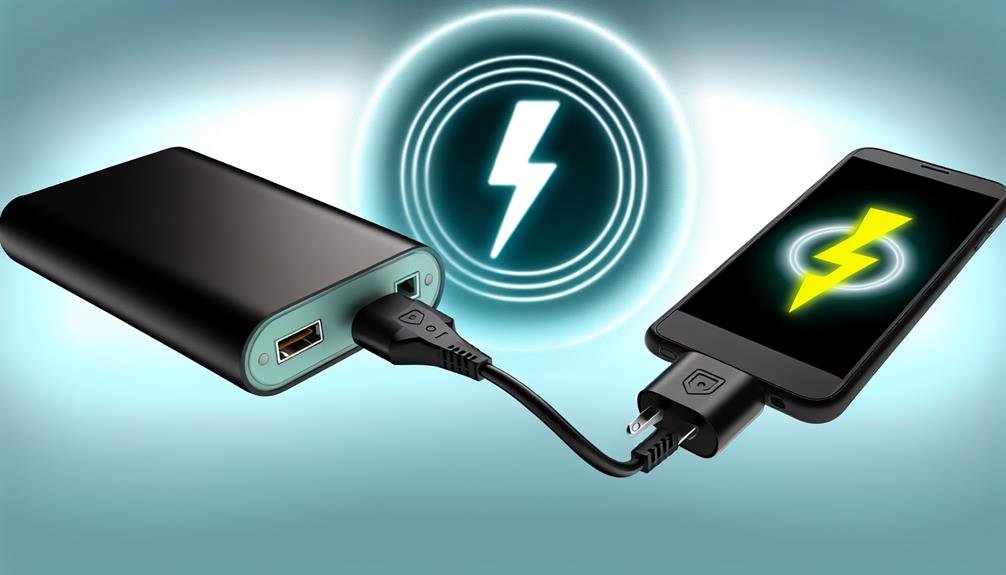
When charging your power bank with a mobile charger, verify charger compatibility to prevent potential damage to the battery. Monitor and manage heat levels during charging to avoid overheating, which can degrade performance and pose safety risks. Additionally, using high-quality cables is essential for maintaining efficient power transfer and reducing the risk of electrical faults.
Charger Compatibility Check
Verifying charger compatibility is important, as using an incompatible charger can not only deteriorate the power bank's performance but also pose significant safety risks, such as overheating or potential fire hazards. To start with, compatibility verification is necessary. This involves checking the specifications of both the power bank and the mobile charger. Look for the voltage requirements on the power bank, typically indicated in volts (V), and verify the charger matches these specifications precisely. Using a charger with higher or lower voltage can impact charging efficiency and potentially damage the power bank.
Additionally, amperage (measured in amps or A) should not be overlooked. While most power banks can tolerate a range of input currents, exceeding the recommended amperage can lead to overheating. It's recommended to consult the user manual for both devices to confirm compatibility.
For safety tips, always use certified chargers and cables. Non-certified accessories may not meet safety standards, increasing the risk of short circuits or fires. Furthermore, avoid charging your power bank in excessively hot environments, as this can worsen overheating issues. By following these guidelines, you can ensure efficient and safe charging of your power bank.
Heat Management Tips
To effectively manage heat during power bank charging, make certain your device is placed in a well-ventilated area away from direct sunlight or heat sources. Excessive heat can degrade battery performance and lifespan. Utilizing proper cooling methods is essential to maintain best temperature control and guarantee safety.
Avoid covering your power bank with insulating materials like cloth or placing it on surfaces with poor heat dissipation. Instead, place it on a hard, flat surface to facilitate better airflow. You might also consider using a small desk fan to enhance ventilation, particularly during high ambient temperatures.
Monitoring the temperature of your power bank during charging is essential. Many modern devices come equipped with built-in temperature sensors and automatic shut-off features to prevent overheating. However, it's advisable to periodically check the device manually. If it becomes uncomfortably warm to touch, disconnect it immediately and allow it to cool down.
Employing these cooling methods not only extends the life of your power bank but also mitigates risks of thermal runaway, which can result in fires or explosions. By prioritizing temperature control, you ensure a safer and more efficient charging experience.
Cable Quality Importance
High-quality cables are necessary for safe and efficient power bank charging, as substandard cables can lead to voltage drops, overheating, and potential damage to both the power bank and connected devices. When selecting a cable, prioritizing both cable durability and connection stability is vital to guaranteeing safety and performance.
Substandard cables often lack the required shielding and quality materials, which can result in inefficiencies and hazards. To ensure you're using the right cable, consider the following factors:
- Insulation Quality: High-grade insulation reduces the risk of short circuits and overheating.
- Connector Integrity: Well-constructed connectors maintain stable connections, minimizing wear and tear on ports.
- Wire Gauge: Thicker wires can handle higher currents without significant voltage drops, enhancing charging efficiency.
- Shielding: Properly shielded cables prevent electromagnetic interference (EMI), guaranteeing consistent performance.
- Certification: Look for cables certified by reputable organizations, indicating they meet safety standards.
Cable Types
When charging your power bank, you'll encounter various cable types, each with distinct connectors and data transfer capabilities. Understanding these differences is essential for ensuring cable compatibility and optimizing charging capacity. The most common connector options include USB-A, USB-C, and Micro-USB. Each of these connectors has specific power output characteristics, which directly affect how efficiently your power bank charges.
USB-A to Micro-USB cables are traditional and widely used, but they typically offer lower charging speeds compared to modern alternatives. For higher power output, consider USB-C cables. These are designed to support faster charging rates and higher data transfer speeds, making them ideal for newer power banks. USB-C to USB-C cables, in particular, can handle significant power loads and are compatible with the latest USB Power Delivery (PD) standards.
When selecting a cable, always verify the charging capacity it can support. Using an incompatible or low-quality cable can result in slower charging times and potentially overheat, posing safety risks. Ensuring that your cable is certified and matches your power bank's specifications will help maintain both performance and safety.
Voltage and Amperage
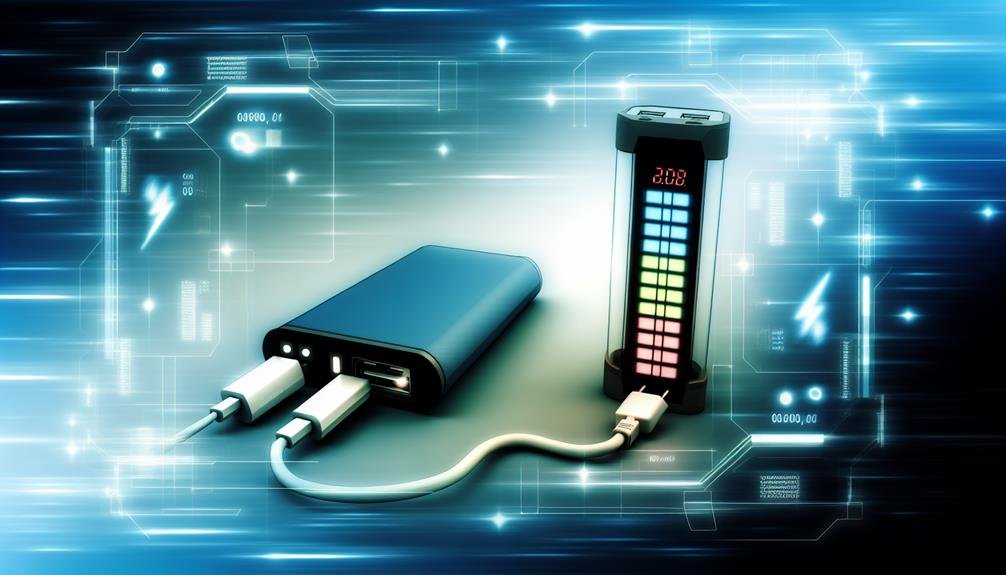
Understanding voltage and amperage is vital for guaranteeing your power bank charges efficiently and safely with your mobile charger. Voltage (V) and amperage (A) are significant parameters that influence how well your power bank interacts with a mobile charger.
- Voltage Compatibility: Confirm the charger's voltage matches the power bank's input voltage. A mismatch can lead to inefficient charging or damage.
- Amperage Output: The charger's amperage should ideally be equal to or greater than the power bank's required input. Using a charger with too low amperage can prolong the charging duration and potentially overheat the charger.
- Power Bank Capacity: Larger capacity power banks (measured in mAh) require chargers with higher amperage to reduce charging time. For example, a 20,000mAh power bank will charge faster with a 2A charger compared to a 1A charger.
- Safety Mechanisms: Modern power banks come with built-in safety mechanisms to manage different amperage levels, but it's essential to use a compatible charger to avoid triggering these safeguards unnecessarily.
- Heat Management: Excessive heat can degrade both the power bank and the charger. Guarantee both devices remain within safe operational temperatures during the charging process.
Charging Efficiency
Maximizing charging effectiveness involves optimizing the interplay between your power bank's capacity and the charger's output to guarantee rapid, safe energy transfer. To achieve this, you need to understand the specifications of both the power bank and the mobile charger. A high-capacity power bank paired with a low-output charger will result in extended charging times, which can negatively impact your battery lifespan.
It's important to match your charging habits with the power bank capacity and the charger's wattage. For example, if your power bank has a 10,000 mAh capacity and your mobile charger outputs 5V/1A, the charging time will be significantly longer compared to using a 5V/2A charger. This not only prolongs the charging duration but also puts unnecessary stress on the battery, thereby reducing its lifespan over time.
Furthermore, utilizing a charger with a higher amperage than what the power bank's input supports can lead to inefficiencies and potential overheating. Hence, always verify that your charger meets the power bank's input specifications. Adopting efficient charging habits—such as regularly monitoring charging progress and avoiding overcharging—will help maintain ideal battery health and longevity. Therefore, understanding these technical details ensures both safety and efficiency in your charging routine.
Potential Risks
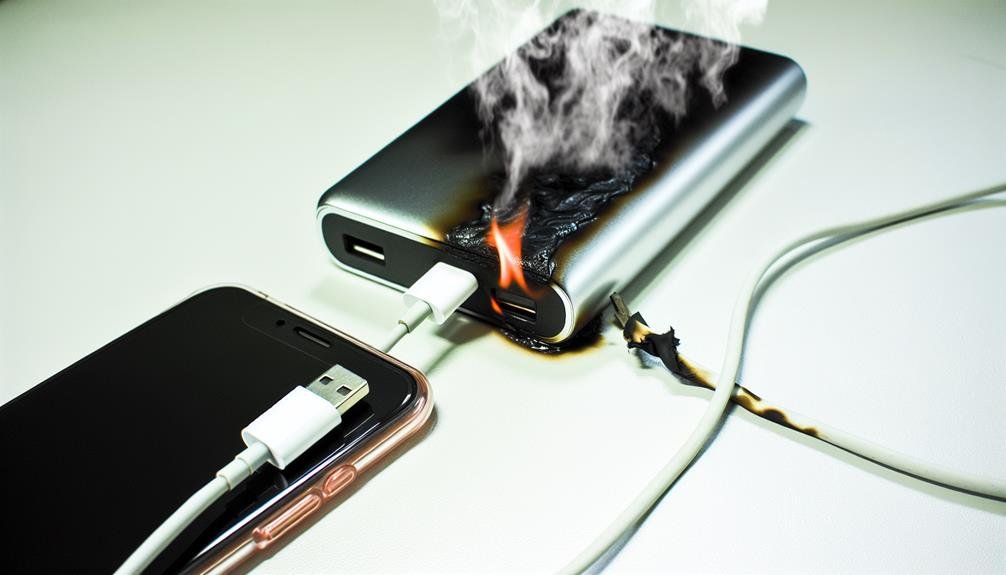
One major risk associated with charging a power bank using a mobile charger is the potential for overheating, which can lead to reduced battery life or, in extreme cases, cause safety hazards such as fire or explosion. Utilizing a charger not specifically designed for your power bank can result in mismatched voltage and current, creating thermal runaway conditions.
Overcharging risks also present significant concerns. Power banks often feature built-in safety mechanisms, but these aren't foolproof, especially when using a charger with different specifications. Overcharging can degrade battery cells, reducing lifespan and efficiency.
Consider these risks carefully:
- Overheating: Incompatible chargers can cause excessive heat, damaging internal components and increasing fire risk.
- Voltage Mismatch: Using a mobile charger not rated for your power bank might lead to voltage inconsistencies, resulting in potential malfunction.
- Current Misalignment: An incorrect current can lead to undercharging or overcharging, both harmful to battery health.
- Safety Mechanism Failures: Over-reliance on built-in safety features can be dangerous; these systems might not handle every anomaly from incompatible chargers.
- Battery Degradation: Frequent use of non-designated chargers can accelerate wear and tear, diminishing battery capacity and performance.
Understanding these potential risks will help you make informed decisions, prioritizing safety and device longevity.
Best Practices
To guarantee the safe and efficient charging of your power bank, adhere to these best practices. First, always use a charger that matches the power bank's input specifications. Mismatched chargers can lead to overheating and compromise battery health. Choose a high-quality mobile charger with overcharge protection features to maintain peak charging etiquette.
Monitor the temperature of your power bank during charging. Excessive heat can degrade internal components and shorten the power bank lifespan. Place the power bank in a cool, ventilated area and avoid charging under direct sunlight or near heat sources.
Adopt disciplined charging habits by not letting the power bank deplete completely before recharging. Keeping the battery level between 20% and 80% can greatly enhance battery health and longevity.
Additionally, unplug the power bank once it's fully charged to prevent overcharging, which can lead to reduced efficiency over time. Regularly inspect cables and connectors for wear and tear to prevent short circuits or electrical hazards.
Frequently Asked Questions
Can I Use My Laptop Charger to Charge a Power Bank?
You shouldn't use your laptop charger to charge a power bank unless it's explicitly compatible. Instead, use a car charger or a wall outlet designed for your power bank to guarantee safety and avoid potential damage.
Do Different Brands of Power Banks Affect Charging Compatibility?
Just like Romeo and Juliet faced compatibility issues, different brands of power banks can affect charging compatibility. Brand considerations are essential; make sure you use certified cables and chargers to maintain safety and best performance.
How Long Does It Take to Fully Charge a Power Bank?
Charging speed and battery lifespan both influence how long it takes to fully charge a power bank. Typically, it can range from 2 to 12 hours, depending on the power bank's capacity and the charger's output specifications.
Can a Power Bank Be Charged Using Solar Panels?
When it comes to charging a power bank with solar panels, it's not always straightforward. Check solar panel compatibility for best charging efficiency. Verify the voltage and amperage ratings to avoid potential safety hazards.
Is It Safe to Charge a Power Bank Overnight?
Charging a power bank overnight can impact battery health and energy consumption. While most modern power banks have safety features, it's best to avoid overcharging to prolong battery life and guarantee efficient energy usage.

